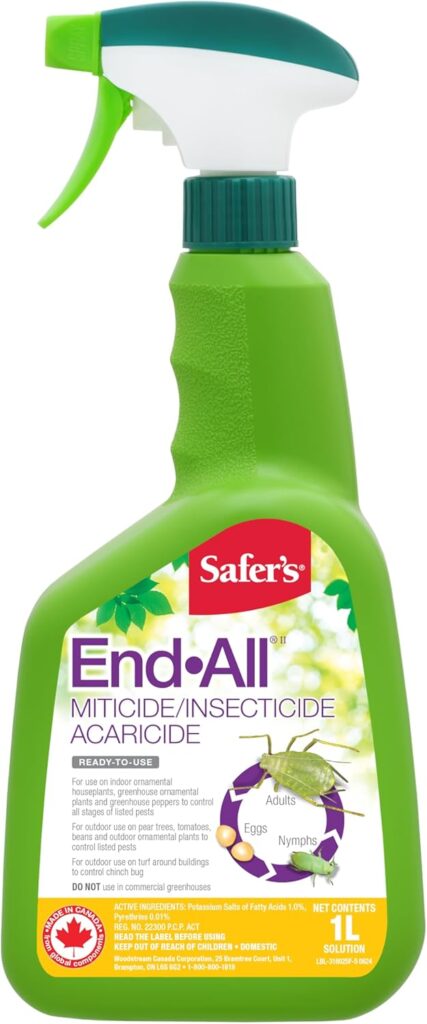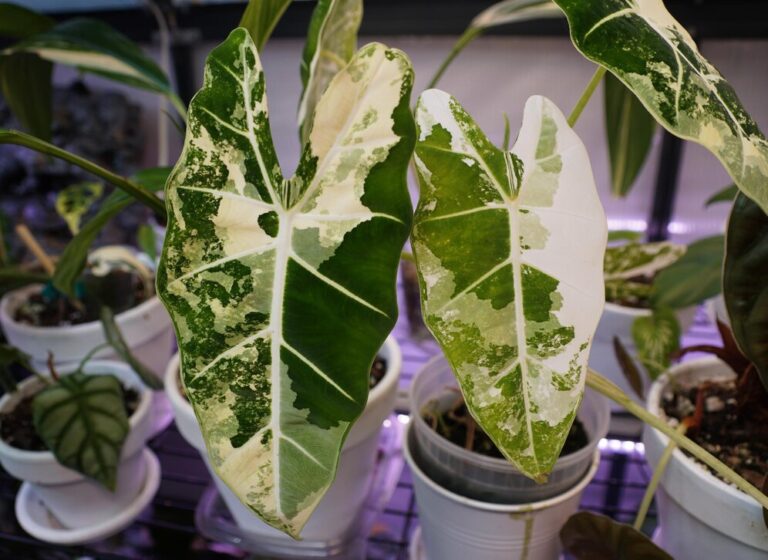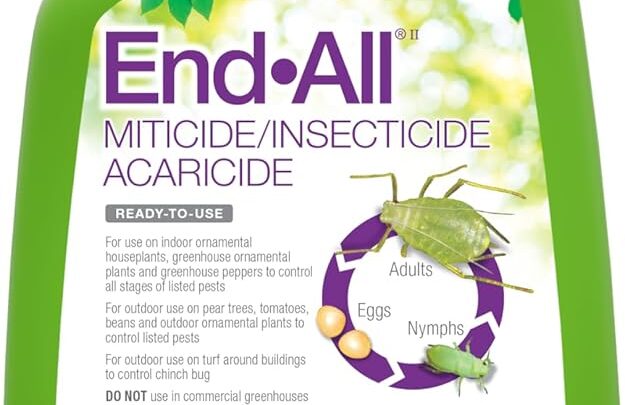This routine helps prevent and suppress common indoor plant pests like thrips, spider mites, aphids, and fungus gnats in a small apartment collection.
Table of Contents
Here’s what you can find in this article.
The Products Used In This Pest Management Routine
Spinosad Spray
Spinosad is a natural, biologically-derived insecticide that works by targeting the nervous system of soft-bodied insects. In an IPM routine, it plays a critical role in knocking down active pests like thrips, fungus gnat larvae, and leaf miners early in the cycle.
Applied every 30 days as a preventative, or every 5–7 days during outbreaks, it’s especially effective at disrupting pest life cycles before populations explode, making it ideal for managing infestations in dense tropical plant collections.
Insecticidal Soap + Neem Oil Spray
The Insecticidal Soap + Neem Oil Spray is a broad-spectrum contact spray that combines insecticidal soap, neem oil, and pyrethrins to kill pests at multiple life stages.
In an IPM routine, it follows Spinosad as the second strike, targeting spider mites, aphids, mealybugs, and eggs missed by other treatments.
It’s most effective when applied 12–14 days after Spinosad, helping to clean up lingering pests and reduce resistance buildup.
As a monthly preventative, it adds extra protection by suppressing pests before visible outbreaks occur.
You can also use our homemade equivalent, the ingredients of which should also be readily available in most areas.
Readily Available Spinosad Spray Products
| Brand/Product Name | Notes |
|---|---|
| Captain Jack’s Deadbug Brew | Most widely available Spinosad spray for home use |
| Monterey Garden Insect Spray | Stronger concentration; often used in garden stores |
| Nature’s Good Guys Spinosad | Often marketed alongside beneficial insects |
| Safer’s Trounce Yard & Garden | Canadian version (contains Spinosad + pyrethrin mix) |
| Green Earth Garden Insecticide | Some variants include Spinosad; check label |
Always confirm that Spinosad is the active ingredient (usually listed as Spinosad A & D or Fermentation product of Saccharopolyspora spinosa).
Readily Available Insecticidal Soap + Neem Oil Spray Products
| Brand/Product Name | Notes |
|---|---|
| Safer’s End All | Classic 3-in-1 (insecticidal soap, neem, pyrethrin); Canada-friendly |
| Garden Safe Insecticidal Soap | Pure soap base; add neem oil separately for full effect |
| Natria Insecticidal Soap | Mild formula; often paired with neem oil |
| Bonide Neem Oil RTU | Cold-pressed neem with some soap emulsifier |
| EcoSense Insecticidal Soap | Good soap-only option in some regions |
| Green Earth Garden Insecticide | Canadian label variant with soap and/or neem oil |
| DIY Spray (homemade concentrate) | Mix insecticidal soap, neem oil, isopropyl, and adhesion oil |
Check labels to confirm active ingredients: ideally potassium salts of fatty acids (soap) + neem oil (clarified hydrophobic extract).
What Pests Does This Pest Management Routine Target?
In trying to keep this routine absolute minimalist (so that I’ll actually do it), I had to make concessions. Compromise was a necessary evil.
Still, this routine helps prevent and suppress a wide range of common indoor plant pests, especially in tropical houseplant collections, and I think does an excellent job of staying on top of the major pests that plague our indoor gardens.
| Pest Type | Affected Plant Areas | Notes |
|---|---|---|
| Thrips | Leaves, stems, moss poles | Spinosad is especially effective; use sticky traps for monitoring |
| Spider Mites | Undersides of leaves, stems | Insecticidal Soap + Neem Oil helps suppress; increase humidity to deter |
| Aphids | New growth, stems | Easily knocked down by both sprays |
| Fungus Gnats | Soil surface, roots | Spinosad kills larvae; yellow traps catch adults |
| Mealybugs | Leaf joints, roots, moss poles | Insecticidal Soap + Neem Oil can suppress light infestations |
| Whiteflies | Undersides of leaves | Both sprays help, but repeat treatment is needed |
| Broad Mites | New growth, twisted leaves | Insecticidal Soap + Neem Oil helps control—watch for stunted tips |
| Scale (soft) | Stems, leaf veins | Insecticidal Soap + Neem Oil can help weaken populations if caught early |
This system is not designed for hard-bodied pests like scale in full armour form, or root rot pathogens, but it catches most sap-sucking soft-bodied insects that plague indoor plants.
When To Apply Each Spray To Your Tropical Plants
| Week | Spray | Purpose |
|---|---|---|
| Week 1 | Spinosad | Targets thrips, fungus gnat larvae, and soft-bodied pests |
| Week 3 | Insecticidal Soap + Neem Oil | Kills mites, aphids, and broad-spectrum pest knockdown |
- Space applications by ~14 days to avoid overlapping harsh chemicals.
- Apply at dusk/lights off to prevent leaf burn and boost effectiveness.
How To Spray Your Plants
- Shake bottles before use.
- Spray thoroughly: leaves (top + bottom), stems, moss poles, soil surface. Spray until run-off, or until plant is dripping.
- Avoid spraying fuzzy or delicate-leaved plants without patch testing.
Additional Pest Management Considerations
- Sticky traps (yellow for gnats, blue for thrips)
- Spot-treat problem areas with extra sprays during outbreaks (every 5–7 days for 2–3 rounds).
- Always monitor for pests, even with IPM in place.
What To Do When You Spot a Pest Infestation
When you notice signs of thrips, mites, or other pests, shift from monthly prevention to active life cycle disruption. This means shorter spray intervals and more consistent observation.
Transition to an Active Integrated Pest Management Cycle
If pests are confirmed (even a small outbreak), follow this intensified 30-day regimen.
Stay consistent. The key to effective control is interrupting the full pest life cycle, which can range from 5–20 days depending on species.
30-Day Active Integrated Pest Management Spray Cycle
(Using Safer’s End All as a placeholder for your Insecticidal Soap + Neem Oil spray)
| Day | Treatment | Notes |
|---|---|---|
| Day 1 | Spinosad | First knockdown: targets thrips, larvae in moss, and fungus gnats |
| Day 3–4 | Safer’s End All | Follow-up miticide for mites, aphids, and eggs missed by Spinosad |
| Day 8 | Spinosad | Repeat to catch hatching larvae |
| Day 10–11 | Safer’s End All | Maintains pressure on mites and new pest waves |
| Day 15 | Spinosad | Third round—catches stragglers, disrupts life cycle |
| Day 17–18 | Safer’s End All | Final knockdown to clean up remaining pests |
Environmental Changes During an Active Integrated Pest Management Cycle
- Quarantine affected plants 3–6 feet away, especially from cabinet setups.
- Add sticky traps to nearby plants to monitor and trap adults.
- Inspect moss poles and upper soil: inject Spinosad if you suspect larvae.
- Increase humidity if spider mites are present (aim for 60–80%).
After 30 Days Of An Active Integrated Pest Management Cycle
If no new pest activity is visible:
- Return to the monthly routine (Spinosad Week 1, Safer’s Week 3).
- Keep sticky traps active.
- Repeat the intensified cycle again if any pests reappear.





